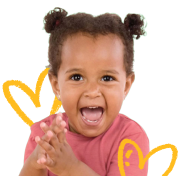
We frequently receive correspondence from early child development professionals looking for ways to introduce babies to baby sign language in the classroom environment. We have received numerous reports from educators around the globe highlighting how baby sign language has been helpful in their classrooms and play groups. Based on the feedback we have received we want to share with you a few of the ways in which learning signs is proving to be helpful for babies, toddlers and preschoolers attending daycare, early childhood intervention and Head Start Programs.
Baby Sign Language Provides Consistent Communication Skills Across Many Backgrounds
Whether a child comes from a different ethnic background or a household with different cultural nuances once a little one makes it to daycare the need to have common means of communication becomes essential to their emotional health and academic progress. By using baby sign language in the classroom both the educator and child can make the connection between words and concepts. For the non-native English speaker knowing the sign for nap will help him or her connect the dots between the action and the word they hear at home. Similarly babies will be able to overcome regional differences and learn synonyms such as binkie or pacifier.
Baby Sign Language Empowers Babies at an Early Stage in Life to Convey Basic Needs
Both at home and at daycare one of the most important reasons to introduce babies to baby sign language is empowerment. A baby who is able to effectively communicate primal needs such as hunger or thirst will be a happier baby with far less chances of resorting to tears or tantrums to convey their frustration. Imagine how impactful it can be if by signing you reduce tantrums in the classroom by at least half. Now you will have more time to teach, love and create memories with the little ones.
Baby Sign Language is Helpful in the Development of Motor Skills
Non-verbals are as important as words when it comes to communication skills. By reinforcing speech with signs not only do we equip toddlers to have clarity in conveying ideas, we also provide them with the means to refine their motor skills and make gestural associations between word and movement. One of the most effective ways to maximize motor skills development through baby sign language is by using key signs in combination with simple songs that highlight age-appropriate activities pointing to self-reliance.
Baby Sign Language Reduces Distractions During Learning Units
Keeping order in the classroom and having the ability to engage the group in activities conducive to learning is essential. Baby Sign Language can give toddlers the means to communicate urgent needs such as potty or thirsty without raising their voice or distracting the rest of the group. This is specially useful during reading circle or group play.
Baby Sign Language Aids in the Development of Social Skills with Peers
There is nothing more frustrating to a little one than wanting to communicate something to a peer and failing due to lack of appropriate words. Baby sign language creates a common language among your students allowing them to better engage with others in play and cooperation. Concepts such as share, mine, more and thanks can make a world of difference on how little ones engage with each other.
If you are a teacher, caregiver or preschool administrator consider our Baby Sign Language Teaching Guide. The guide contains advanced teaching methods suitable for the classroom. In tandem with our core signs Flash Card Set you can begin introducing babies & toddlers in your classroom to the world of signing.




